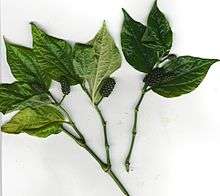Piper lolot
- "Lá lốt" redirects here. This can also refer to the related Piper sarmentosum.
| Lolot | |
|---|---|
 | |
| Scientific classification | |
| Kingdom: | Plantae |
| (unranked): | Angiosperms |
| (unranked): | Magnoliids |
| Order: | Piperales |
| Family: | Piperaceae |
| Genus: | Piper |
| Species: | P. lolot |
| Binomial name | |
| Piper lolot C.DC. | |
Piper lolot (lolot) is a flowering vine in the family Piperaceae, cultivated for its leaf which is used in Lao and Vietnamese cuisine as a flavoring wrap for grilling meats, namely the thịt bò nướng lá lốt sausages of Vietnam.[1] It is also known as lolot pepper.[2]
In Vietnamese it is called lá lốt (or sometimes in the South lá lốp). In Khmer, it is called japloo ចាព្លូ (or jeeploo ជីរភ្លូ), in Thai chaphloo ชะพลู, in Lao phak ee lert ຜັກອີ່ເລີດ (or phak nang lert ຜັກນາງເລີດ).
This plant is a perennial herb with creeping rhizomes, and a striped stem that grow to 40 cm high. Its leaves are thin, heart-shaped, and 8–10 cm long and 8–11 cm wide, with 5 main veins from the base of the blade, oil glands on the upper surface, and finely pubescent veins on its under side. Its petioles are 2.5–3 cm long. Erect white spikes of 1–2 cm long emerge at the axils.[3]
The practice of wrapping meat in vine leaves originated in the Middle East, which was taken to India by the Persians.[4] It was subsequently introduced by the Indians to Southeast Asia. However, grape vines do not grow well in tropical climates, so the Vietnamese started to use leaves of lolot instead.[4] It is native to the Indochinese region and recently introduced to the United States by Lao and Vietnamese emigrants.[2] It is also used for medicinal purposes, to relieve a wide range of symptoms from inflammation to snakebites.
See also
Notes
- ↑ McGee, Harold (2004). On Food and Cooking (Revised Edition). Scribner. p. 410. ISBN 0-684-80001-2.
- 1 2 Seidemann, Johannes (2005). World Spice Plants: Economic Usage, Botany, Taxonomy. Springer. p. 292. ISBN 3-540-22279-0.
- ↑ Tanaka, Yoshitaka; Van Ke, Nguyen (2007). Edible Wild Plants of Vietnam: The Bountiful Garden. Thailand: Orchid Press. p. 111. ISBN 9745240893.
- 1 2 Davidson, Alan (1999). The Oxford Companion to Food. Oxford University Press. p. 828. ISBN 0-19-211579-0.